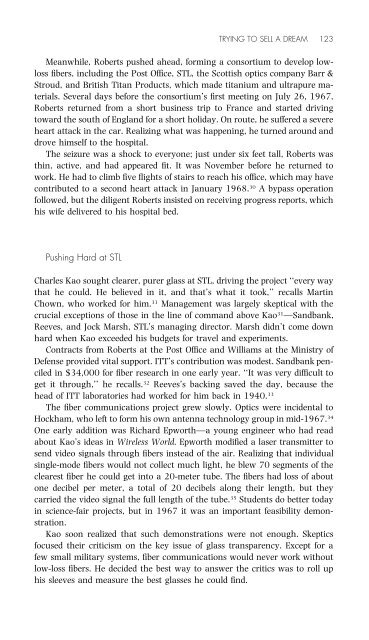City of Light: The Story of Fiber Optics
City of Light: The Story of Fiber Optics
City of Light: The Story of Fiber Optics
Create successful ePaper yourself
Turn your PDF publications into a flip-book with our unique Google optimized e-Paper software.
TRYING TO SELL A DREAM 123<br />
Meanwhile, Roberts pushed ahead, forming a consortium to develop lowloss<br />
fibers, including the Post Office, STL, the Scottish optics company Barr &<br />
Stroud, and British Titan Products, which made titanium and ultrapure materials.<br />
Several days before the consortium’s first meeting on July 26, 1967,<br />
Roberts returned from a short business trip to France and started driving<br />
toward the south <strong>of</strong> England for a short holiday. On route, he suffered a severe<br />
heart attack in the car. Realizing what was happening, he turned around and<br />
drove himself to the hospital.<br />
<strong>The</strong> seizure was a shock to everyone; just under six feet tall, Roberts was<br />
thin, active, and had appeared fit. It was November before he returned to<br />
work. He had to climb five flights <strong>of</strong> stairs to reach his <strong>of</strong>fice, which may have<br />
contributed to a second heart attack in January 1968. 30 A bypass operation<br />
followed, but the diligent Roberts insisted on receiving progress reports, which<br />
his wife delivered to his hospital bed.<br />
Pushing Hard at STL<br />
Charles Kao sought clearer, purer glass at STL, driving the project ‘‘every way<br />
that he could. He believed in it, and that’s what it took,’’ recalls Martin<br />
Chown, who worked for him. 31 Management was largely skeptical with the<br />
crucial exceptions <strong>of</strong> those in the line <strong>of</strong> command above Kao 31 —Sandbank,<br />
Reeves, and Jock Marsh, STL’s managing director. Marsh didn’t come down<br />
hard when Kao exceeded his budgets for travel and experiments.<br />
Contracts from Roberts at the Post Office and Williams at the Ministry <strong>of</strong><br />
Defense provided vital support. ITT’s contribution was modest. Sandbank penciled<br />
in $34,000 for fiber research in one early year. ‘‘It was very difficult to<br />
get it through,’’ he recalls. 32 Reeves’s backing saved the day, because the<br />
head <strong>of</strong> ITT laboratories had worked for him back in 1940. 33<br />
<strong>The</strong> fiber communications project grew slowly. <strong>Optics</strong> were incidental to<br />
Hockham, who left to form his own antenna technology group in mid-1967. 34<br />
One early addition was Richard Epworth—a young engineer who had read<br />
about Kao’s ideas in Wireless World. Epworth modified a laser transmitter to<br />
send video signals through fibers instead <strong>of</strong> the air. Realizing that individual<br />
single-mode fibers would not collect much light, he blew 70 segments <strong>of</strong> the<br />
clearest fiber he could get into a 20-meter tube. <strong>The</strong> fibers had loss <strong>of</strong> about<br />
one decibel per meter, a total <strong>of</strong> 20 decibels along their length, but they<br />
carried the video signal the full length <strong>of</strong> the tube. 35 Students do better today<br />
in science-fair projects, but in 1967 it was an important feasibility demonstration.<br />
Kao soon realized that such demonstrations were not enough. Skeptics<br />
focused their criticism on the key issue <strong>of</strong> glass transparency. Except for a<br />
few small military systems, fiber communications would never work without<br />
low-loss fibers. He decided the best way to answer the critics was to roll up<br />
his sleeves and measure the best glasses he could find.

















